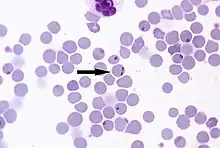Babesia divergens
Babesia divergens is an intraerythrocytic parasite, transmitted by the tick Ixodes ricinus. It is the main agent of bovine babesiosis, or "redwater fever", in Europe. Young cattle are less susceptible. The current emphasis in Europe on sustainable agriculture and extensification is likely to lead to an increase in vector tick populations with increased risk of infection.[1] B. divergens is also prevalent (infection rates of 11-23%) in cottontail rabbits on Nantucket Island, MA, USA.[2]

| Babesia divergens | |
|---|---|
| Scientific classification | |
| Domain: | Eukaryota |
| Clade: | Diaphoretickes |
| Clade: | TSAR |
| Clade: | SAR |
| Clade: | Alveolata |
| Phylum: | Apicomplexa |
| Class: | Aconoidasida |
| Order: | Piroplasmida |
| Family: | Babesiidae |
| Genus: | Babesia |
| Species: | B. divergens |
| Binomial name | |
| Babesia divergens M'Fadyean & Stockman, 1911 | |
Human infections are rare.[3] The most severe, life-threatening infections were described in asplenic patients.[3] Infections in immunocompetent patients were also observed, and described as a "serious influenza-like" syndrome that requires medical treatment.[4]
References
- Zintl, A; Mulcahy, G; Skerrett, HE; Taylor, SM; Gray, JS (2003). "Babesia divergens, a Bovine Blood Parasite of Veterinary and Zoonotic Importance". Clinical Microbiology Reviews. 16 (4): 622–36. doi:10.1128/CMR.16.4.622-636.2003. PMC 207107. PMID 14557289.
- Heidi K. Goethert & Sam R. 3rd Telford (2003). "Enzootic transmission of Babesia divergens among cottontail rabbits on Nantucket Island, Massachusetts". The American Journal of Tropical Medicine and Hygiene. 69 (5): 455–460. doi:10.4269/ajtmh.2003.69.455. PMID 14695079. S2CID 2418317.
- Uguen, C; Girard, L; Brasseur, P; Leblay, R (1997). "La babésiose humaine en 1997" [Human Babesiosis in 1997]. La Revue de Médecine Interne (in French). 18 (12): 945–51. doi:10.1016/S0248-8663(97)80114-2. PMID 9499998.
- Martinot, M; Zadeh, MM; Hansmann, Y; Grawey, I; Christmann, D; Aguillon, S; Jouglin, M; Chauvin, A; de Briel, D (2011). "Babesiosis in Immunocompetent Patients, Europe". Emerging Infectious Diseases. 17 (1): 114–6. doi:10.3201/eid1701.100737. PMC 3204631. PMID 21192869.
Further reading
- Castro, Emma; Gonzalez, Luis Miguel; Rubio, Jose Miguel; Ramiro, Raquel; Girones, Nuria; Montero, Estrella (September 2014). "The efficacy of the ultraviolet C pathogen inactivation system in the reduction of Babesia divergens in pooled buffy coat platelets". Transfusion. 54 (9): 2207–2216. doi:10.1111/TRF.12598. PMID 24666393. S2CID 23879006.
- Lobo, Cheryl-Ann (January 2005). "Babesia divergens and Plasmodium falciparum Use Common Receptors, Glycophorins A and B, To Invade the Human Red Blood Cell". Infection and Immunity. 73 (1): 649–651. doi:10.1128/IAI.73.1.649-651.2005. PMC 538995. PMID 15618210.
- Rar, V.A.; Epikhina, T.I.; Suntsova, O.V.; Kozlova, I.V.; Lisak, O.V.; Pukhovskaya, N.M.; Vysochina, N.P.; Ivanov, L.I.; Tikunova, N.V. (December 2014). "Genetic variability of Babesia parasites in Haemaphysalis spp. and Ixodes persulcatus ticks in the Baikal region and Far East of Russia". Infection, Genetics and Evolution. 28: 270–275. doi:10.1016/j.meegid.2014.10.010. PMID 25460820.
- Rodriguez, Marilis; Alhassan, Andy; Ord, Rosalynn; Cursino-Santos, Jeny; Singh, Manpreet; Gray, Jeremy; Lobo, Cheryl (September 2014). "Identification and Characterization of the RouenBd1987 Babesia divergens Rhopty-Associated Protein 1". PLOS ONE. 9 (9): e107727. Bibcode:2014PLoSO...9j7727R. doi:10.1371/journal.pone.0107727. PMC 4166668. PMID 25226276.